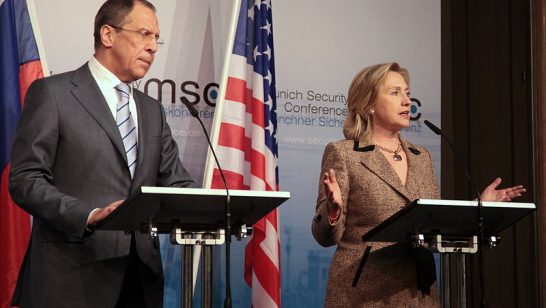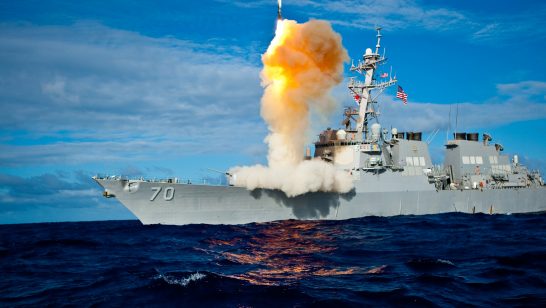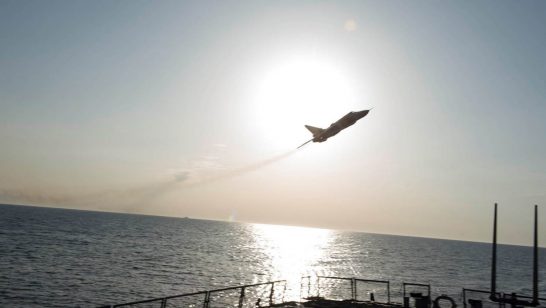
On June 1 2017, ELN Director Sir Adam Thomson delivered the keynote speech at the UK Project on Nuclear Issues [PONI] 2017 Annual Conference in London. You can find the video here of Sir Adam’s keynote speech. The full speech is below.
*****
I have been asked to say something brief about NATO and nuclear in a changing security landscape, including the role of the UK deterrent in NATO given Brexit. I’ll do so. But I hope you will not mind if I range more widely too. As I do so, please understand that I now speak in an entirely personal capacity and as Director of the European Leadership Network, and not as a representative of HMG.
Context
As usual, we feel ourselves to be at an inflection point in international affairs. We always do. And this applies as much to nuclear as to other security matters.
First, things are headed in directions that give nuclear issues more profile. The majority of states are fed up waiting for the P5 and are negotiating a nuclear ban treaty. North Korea and Putin in their different ways are rattling nuclear sabres, more than in recent years. A new US President wants the US to remain “top of the pack”.
Second, things seem particularly fluid. The Iran nuclear deal still hangs in the balance. Early stages of major modernisation for at least the UK, US and French nuclear deterrents are being worked on. Things are being decided now that will influence for many years to come. New technologies are disrupting old equations. There’s an uncertain and unsafe outlook in the NATO-Russia deterrence relationship.
So what direction will NATO and the rest of the world now take? Answers in the next 12 or 18 months could determine the next few decades.
First a few observations about where we are. Then some thoughts about where we might go.
Where has NATO got to?
NATO is not immune from the greater prominence that nuclear capability is re-acquiring internationally. There is no area of NATO life that has not been affected by the annexation of Crimea. And that includes nuclear policy.
But the Alliance has moved cautiously on nuclear since 2014. True, modernisation that was already under considerationhas been continued. The prospect of serious consideration of B-61 withdrawal from Europe has receded. The Alliance remains an explicitly nuclear one. On the other hand, NATO has not yet – so far as I know – taken some of the steps that might seem to be in the logic of a renewed deterrence relationship with Russia: no resumed linkage between conventional and nuclear to create a more explicit escalation chain; no consequent exercising of nuclear with conventional; and none of the conscious signalling of nuclear determination in the many ways that Moscow is so good at and so stupid about. There has been no desire at NATO, still less any attempt, to rewrite the hard fought 2012 Deterrence and Defence Posture Review.
It’s illuminating that there has, if anything, been more focus in the Alliance in the last 2 years or so on cyber than on nuclear. Rightly or wrongly, hybrid is the preoccupation. Unlike the last Cold War, NATO at least technically has conventional superiority and doesn’t need to dwell as heavily as Russia on the nuclear dimension. And after a 25 year holiday from hard security, most Allies have no appetite for doing so.
So my experience at NATO was that the UK is currently respected more for its diplomacy and its conventional military power than for its nuclear status. And, for all the uncertainties around President Trump’s commitment to the Alliance, the recent talk of a European nuclear deterrent and all the upheavals of Brexit, my sense is that this is unlikely to change. In other words, yes the UK is recognised as one of the Alliance’s three nuclear powers but that is not going to be a prominent feature of the UK position and positioning in NATO.
True, NATO’s Warsaw Summit communique had new language about the UK and French nuclear deterrents as separate centres of decision making. But this was not new doctrine. And although Brexit may tempt the British government to place greater political weight on its NATO roles, I see no easy UK wins from dwelling particularly on the nuclear dimension. That is where I think we are.
So where do we go from here: the UK and NATO?
If I am right that our choices in the next year or two – say between now and the 2018 UN High Level Conference on Nuclear Disarmament – may determine much about nuclear weapons policy for the next few decades, then I feel bound to ask not just what I think, but what my children may think about our choices. Nuclear is a very long haul proposition.
The probability of getting rid of nuclear weapons in our lifetimes seems vanishingly small. The probability of a nuclear device being used in anger somewhere in the world at some point in the next 70 years – my children’s lifetime – seems to me high. Clock should be at 1.5 not 2.5 minutes to midnight.
So what would my children wish I had done in my professional career to lower that probability of nuclear weapons use? Or that NATO had done? I think perhaps four things and I just want to quickly run through those.
1) Mitigating risk
The easiest path – even if not an easy one – for NATO and for the USA as it refreshes the triad, for France as it modernises and for the UK as it pursues the Trident successor, will be to slip into rather 20th century style of deepening nuclear action and reaction with Russia.
If that is going to be the case, my children would want me at least to have made the modern NATO-Russia deterrence relationship as safe as possible, to have mitigated the known risk. There is much to be desired – for example, caring about nuclear postures as per your first and third sessions [of the PONI conference]; clear nuclear signalling, accurate reading of the other, coherence and stability of military plans, and a disciplined NATO-Russia dialogue. I repeat, in my view, the NATO-Russia deterrence relationship is not safe. It is less safe than in the second half of the 20th century Cold War. Something needs to be done about that.
2) Reducing risk
That’s already a large agenda. But knowing my children, I don’t think they would be satisfied for me to stop there. They would feel that it was not enough to have mitigated known risks. I should have tried to reduce the nuclear risk more absolutely. And at the moment things are headed in the wrong direction. The INF treaty is fraying. Russia has suspended last year its participation in the Plutonium Disposal agreement. Trump has declared New START to be “a bad deal”. The Iran nuclear deal may be the last gasp of classic nuclear diplomacy. Not so much the future for the 21st century but a hold-over from the 20th.
There are things NATO could do here. It won’t be particularly unilateral. Although humans can be altruistic, states rarely are. It is the job of NATO allies to give something for nothing. So stepping back from nuclear risk is far more likely to be a multilateral process not a unilateral one. That is a pity, because multilateral is far more difficult to achieve. But it does mean that nuclear dialogue has to be encouraged.
As far as NATO is concerned, it just isn’t sensible for there to be no nuclear dialogue with Russia. Dialogue would not be a return to business as usual but rather a start to business that needs to be done.
There is space here for a much stronger voice from European Allies, above all on INF, which affects Europe so directly. But also on the impact of new technologies such as the possible vulnerabilities of nuclear capabilities to cyber attack or cyber manipulation. And it’s not hard to see a clear role here for London or Paris or both, if they chose to take it. But NATO is not talking about this right now. Nor, so far as I know, is London.
3) New technologies
A third thing, after mitigating risks and trying to reduce them by tackling some of the basic classic arms control, is to look at new technologies.
Both people and states find it easier to give up birds in the bush than birds in the hand. So addressing nuclear modernization and disruptive new technologies ought to be easier than reducing capabilities and technologies in which states and their military-industrial complexes are already heavily invested. The absence of arms control around ballistic missile defence or prompt global strike or drones or many other emerging technologies strikes me as shockingly casual. So I am glad that UK PONI are discussing technologies, hats off to President Steinmeier for at least trying on conventional arms control and let’s work to get the policy community more mobilised on multilateral new technology arms control, including nuclear. NATO again may be doing the basics of a deterrence relationship with its potential adversaries but there is no sense at the moment of innovation, imagination, or forward-thinking.
4) Policy culture
Which brings me to my final and major, if modest, point that I think would make to me: policy culture. The mindsets we swim in make it unlikely that merely being careful about our own and others’ nuclear postures, or pursuing constructive dialogue about existing risks, or negotiating down the future risks, is going to achieve more than inadequate muddling forward.
As they sit dying with their children on the beach in a radioactive wasteland, my children would wish that I and my kind at NATO had taken the risks a bit more seriously – accepting always, as the reasonable people that they are, that we were hampered by having to treat as a mere probability what for them had suddenly become an actual fact.
To change an international strategic culture on something as close to national sovereignty and as emotional as nuclear – for nuclear have nots as much as haves – would take some awfully big shifts. I wonder whether step by step will ever be enough, even though the international culture would change with each step. Chernobyl wasn’t enough to affect nuclear weapons planning. Even the Cuban Missile Crisis, although it fed US-Soviet arms control, did not stop an extremely dangerous arms race. And right now the bandwidth in most NATO governments for serious attention to nuclear risks or even nuclearmanagement is not growing and is in some capitals shrinking. Maybe a horrific outcome on the Korean peninsula or an accident between India and Pakistan would completely change the political weather. But I don’t think my children would really countenance disaster, even in someone else’s back yard, as a very satisfactory way forward. So I’m particularly interested in your Session Two on ‘Communicating Nuclear’. Communicating nuclear is obviouslydifficult. And yet it’s a high and rising priority.
What’s happening on social media? When did a nuclear meme last go viral? If we want more risk management, more attention to disruptive change, more respect for the adversary, we need to foster a popular and strategic international culture – so both in the public and in government – that is as serious about nuclear risks as about climate change. I hope you will do that.
A closing suggestion: when I was a child in Washington DC after the Cuban Missile Crisis my school class had to practice diving under our flimsy, wooden-topped, metal-framed desks to shelter ourselves from imagined nuclear blasts. Even at the age of seven this seemed to me a plan unlikely to be very successful. But at least the memory has stayed with me.
The opinions articulated above represent the views of the author(s), and do not necessarily reflect the position of the European Leadership Network or any of its members. The ELN’s aim is to encourage debates that will help develop Europe’s capacity to address the pressing foreign, defence, and security challenges of our time.



